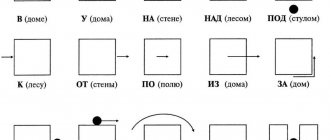When articulating the sound [g]
- The lips take the position of the next sound.
- The distance between the incisors depends on the vowel following r.
- The tip of the tongue is lowered and does not touch the lower incisors. The front and middle parts of the back of the tongue are lowered, the back of the back of the tongue forms a bridge with the palate. The lateral edges of the tongue are pressed against the upper molars.
- The soft palate is raised and pressed against the back wall of the pharynx, thus the passage into the nasal cavity is closed, the air stream goes through the mouth.
- The vocal folds close and vibrate at the moment preceding the explosion of the closure between the tongue and palate as a result of the passage of the exhaled stream of air. A ringing, hard sound is produced [g].
When articulating the sound [k]
- The lips are in the position following the k vowel, not tense.
- The distance between the incisors depends on the vowel following k.
- The tip of the tongue is lowered and does not touch the lower incisors. The anterior and middle parts of the wall of the tongue are lowered, the back part of the wall of the tongue forms a bridge with the palate. The lateral edges of the tongue are pressed against the upper molars.
- The soft palate is raised and closes the passage into the nasal cavity.
- The vocal folds are open. The exhaled stream explodes the closure between the tongue and the palate, resulting in a characteristic noise.
Correct tongue position - why is it important?
For the correct formation of a bite and coherent speech, the correct functioning of all elements of the dental system is important.
The position of the tongue also plays an important role. Under normal conditions, the tongue should exert slight pressure on the upper row of teeth, which contributes to the formation of a correct bite in childhood. The physiological position of the tongue has the following positive effects:
- The development of the upper jaw is stimulated, both in length and width.
- Blood microcirculation in the nasopharynx area improves. This helps strengthen local immunity, which is important, in particular, for protection against respiratory infections.
- Balance improves, which is a prerequisite for the formation of correct posture.
- The normal tone of the facial muscles is maintained in a calm state.
Tongue position - what does it affect?
The correct position of the tongue is the key to a physiological bite, as well as the absence of problems with swallowing, chewing and speech. Let's look at the main negative consequences that arise when the tongue is positioned incorrectly.
If the tongue is pushed back:
- Swallowing disorder is a disorder in the synchronization between swallowing and breathing.
- Pulling the lower jaw back.
- Dysfunction of the auditory tube.
- Violation of voice formation.
If the tongue is moved forward:
- Swallowing disorder.
- The lower jaw is pulled forward.
- Violation of voice formation.
- Curvature of teeth, especially the front ones.
- Protrusion of the tongue forward.
- Decreased lip tone (up to complete loss).
- Excessive tension transmitted to certain muscles and joints of the dental system.
Symptoms that occur due to improper tongue position include:
- violation of nasal breathing;
- swallowing disorder;
- speech defects;
- neuromotor development disorder;
- symptoms from ENT organs;
- malocclusion and other dental problems;
- dysfunction of the temporomandibular joint (TMJ);
- emotional disturbances.
Why is the tongue positioned incorrectly?
There are several reasons that have a direct impact on the position of the tongue in the oral cavity:
- Nasal breathing disorder . This causes the tongue to move downwards. Such changes are necessary to facilitate oral breathing. Let us remember that mouth breathing, in turn, contributes to the formation of malocclusion. Therefore, parents need to closely monitor the respiratory condition of their children.
- Short bridle . In this case, the tongue is “sandwiched” by the short frenulum in a lowered position. Physically, the tongue is not able to fully press against the palate (the position of the tongue is physiologically correct).
- Curvature in the cervical spine . Dysfunction of the cervical spine has a direct impact on the position of the tongue.
- Disorders of muscles and nerves . Dysfunction of certain nerves and muscles of the maxillofacial area can cause improper tongue position. For example, this applies to the work of the glossopharyngeal and hypoglossal nerves, as well as the styloid-glossus and palatoglossus muscles. Disorders of the functions of these nerves and/or muscles lead not only to incorrect tongue position, but also to impaired swallowing and breathing.
The position of the tongue is also influenced by several factors, namely:
- Factors of intrauterine development - multiple pregnancy, uterine anomalies, uterine hypertonicity and others.
- Hereditary factors.
- Injuries to the fetus during childbirth.
- Prematurity.
- Artificial feeding. If a child is forced to be bottle-fed, then the development of the bite and dental system must be carefully monitored.
- Late introduction of solid food (when the child has been on a liquid diet for a long time).
- Bad habits – thumb sucking, object sucking, cheek biting, prolonged sucking of pacifiers.
- Premature loss of baby teeth.
- Frequent respiratory diseases (in particular, chronic sinusitis, enlarged adenoids and other diseases).
Teeth marks on the tongue are one of the signs of improper tongue position
Types of tongue malposition
There are 7 options for tongue position. The first one is correct, and all the others are variants of the incorrect location of the organ. Let's take a closer look at them.
Option 1 – physiologically correct tongue position
The palatal position of the tongue is considered correct1. The tongue at rest is pressed against the palate and is located behind the upper incisors. With this arrangement of the organ, a physiologically correct bite is initially formed (unless, of course, there are other reasons and factors for the development of pathological occlusion). In this case, for the formation of a correct bite, the general muscle tone of the face, the work of the temporomandibular joint and other elements of the dental system are also important.
Option 2 – loose fit to the palate
In this case, the tongue rests approximately 0.5 cm above the lingual tubercles. Also, the tongue may drop down by about 0.5-0.8 cm. Under such circumstances, the organ is not pressed tightly against the palate.
When swallowing in this case, the tongue will rest against the upper or lower incisors. This leads to tension in the muscles of the lower lip, which in turn tilts and crowds the lower teeth.
Option 3 - the tongue passes between the molars
With this arrangement, the tongue covers the lingual cusps. The tone of the lower lip is impaired, which leads to the formation of a deep bite. In this case, the lower teeth often crowd together due to lack of space.
It is noteworthy that over time, the severity of a deep bite may increase, and the lower jaw may shift to a posterior position. In this case, the person complains of limited mobility of the lower jaw (in particular, when opening the mouth).
Option 4 – the tongue covers the buccal and lingual cusps
If the tongue covers the buccal and lingual cusps of the lower molars and/or premolars, then in childhood this leads to problems with teething. The tongue puts pressure on the buds of baby teeth, preventing the latter from erupting. In the future, this may lead to disruption of the formation of the roots of permanent teeth. There is even a risk of tooth root resorption, which leads to adentia (tooth loss).
With the 4th variant of the tongue position, the muscle tone of the lips decreases. In such a situation, an inadequate load is placed on the temporomandibular joint, which leads to disruption of its function.
Option 5 – low tongue position
When the tongue is low, it becomes stiff. Often the tip and middle part of the tongue have increased tone. For this reason, such a language visually appears to be overly large. However, it is not. The tongue is of normal size, but the volumetric effect creates tone.
The low position of the tongue has a significant impact on the dental system, in particular the lower jaw. For this reason, excessive development of the lower jaw (macrognathia) with the formation of a mesial bite is possible. There is also a danger of underdevelopment of the upper jaw, which also forms a mesial bite.
When the jaw moves forward, the functioning of the jaw joints is also disrupted. This leads to characteristic clicking and pain when trying to open the mouth.
Option 6 – tongue between the upper and lower incisors
Often, with this position of the tongue, the orbital muscles of the mouth are weakened and the masticatory tone of the muscles is reduced. This is another option for the “low” location of the organ. Most often, in the 6th position, the tongue is not active enough, which leads to the development of speech defects. The distortion of whistling sounds is especially noticeable.
If with this arrangement the tone of the masticatory muscles is also disturbed, then lengthening of the face is possible, as well as discomfort and pain in the jaw joints. This is due to a violation of the distribution of loads on the facial muscles.
Option 7 – lateral position
Most often, the reason for this position of the tongue is bad habits (thumb sucking, biting nails, pens, etc.). Impaired innervation is another reason for lateral displacement of the tongue.
When the tongue is in a lateral position, swallowing is impaired. The tongue will put pressure on the side of the dental system where it deviates. This leads to uneven development of the jaws.
Articulation. Basic Concepts
Category: Phonetics Don't have time to read the article now?
Read it in your free time on your favorite social network - click on the buttons below! In this article we will look at the basic concepts associated with articulation (the joint work of the speech organs necessary to pronounce speech sounds).
Dorsal is a style in which the tip of the tongue is at the base of the lower teeth. The back of the tongue is arched. The place of articulation is at the tip of the tongue and the lower teeth.
Apical is the position in which the tip of the tongue is on the most convex part of the alveoli. The place of articulation is at the tip of the tongue and the convex part of the alveoli.
The place of articulation is where the bow occurs and sound is created.
Pronunciation is the process of clear and correct sound and intonation design of a statement.
Articulation is the position and movements of the speech organs, which in their interaction produce the sounds of the language.
Pronunciation includes concepts such as:
- Intonation (stress, rhythm, timbre, pause, tempo)
- Articulation (speech organs)
- movable (tongue, lips, soft palate)
- motionless (teeth, alveoli, hard palate)
Training to improve the situation
It is possible and necessary to correct the position of the tongue. Myofunctional therapy has been developed for this purpose. It is used for both therapeutic and preventive purposes. The advantages of this treatment are that it can be performed at any age and at any stage of orthodontic treatment. In addition, mewing does not require special skills or experience. Myofunctional orthodontics specialists will simply show you exercises that need to be performed regularly. The patient’s task is to perform the complex in strict accordance with the doctor’s recommendations.
Here are some common exercises that will help correct the position of your tongue:
- Place your lips behind your lower teeth, press your tongue to the roof of your mouth, and tighten your chin. Hold this position for 5 seconds, then relax your muscles. Repeat 10 times.
- Place your tongue behind your upper teeth, lengthen your chin and tense your lower jaw and hold for 10 seconds. Repeat 10 times.
- The tongue must be placed in the palatine cavity and tense. Stay in this position for 10 seconds, then relax. Repeat 10 times.
- The starting position is the same as in the previous exercise. Now try to swallow saliva without using the muscles of your cheeks and lips. Only the muscles of the tongue should work. This exercise will be difficult for you at first, but every time you do it you will notice progress. Repeat 10 times.
- The starting position is the same as the previous exercise. Tighten your tongue and smile. Then use your index fingers to press on the corners of your mouth, trying to hold back your smile. After 10 seconds you can relax. Repeat 10 times.
- Pull your tongue forward as far as possible, trying to reach your chin. Hold for 5 seconds. Repeat 15 times.
- Extend your tongue, trying to reach the tip of your nose. Hold for 5 seconds. Repeat 15 times.
Features of the construction of the speech apparatus:
- Power mechanism: diaphragm, lungs, trachea, larynx, oral cavity, nasal cavity
- Vibration mechanism: vocal cords
- Resonator: nasal cavity, oral cavity, pharynx
- Mechanism that forms an obstacle to the passage of air: tongue (tip, anterior, middle, posterior part of the tongue), lips, teeth, soft palate and uvula, hard palate and alveoli.
Rhythm is the combination of stressed and unstressed syllables and the relative speed of their pronunciation.
It is necessary to distinguish between phrasal stress and logical :
Phrase stress - both in Russian and in English, a number of words lose their stress in a sentence (mainly function words, prepositions, conjunctions, pronouns).
Logical stress - unlike phrasal stress, often the main semantic load falls on one word (and even on function words). When the logical stress changes, the sentence changes its purpose, that is, it answers different questions.
The rhythm of English speech is characterized by the fact that stressed syllables follow each other at more or less regular intervals, regardless of the number of unstressed syllables between them, therefore, the more unstressed syllables between two stresses, the faster each of them is pronounced.
In English, two or more stresses are possible within a word, but in Russian there is only one.
Was the article useful? Click on the button below and save it to your social network 
Previous articles
Vowel sounds in different varieties of English
Rules for reading English vowels
Differences between British and American English. Pronunciation
FAQ
Will I be able to correct my malocclusion if my tongue position remains incorrect?
Modern orthodontics has a wide range of methods for correcting malocclusion. At the same time, bite correction must be comprehensive. A prerequisite is the elimination of all causes and factors leading to the formation of malocclusion. This also applies to correcting the position of the tongue.
Will myogymnastics help correct the situation?
Yes. Exercises will help correct the position of the tongue. But sometimes exercise is not enough. Additionally, orthodontic treatment to correct the bite is required. In some cases, surgery is needed.
Should the tongue rest on the teeth?
No, it should be located behind the teeth.
When articulating the sound [k']
The lips stretch a little and reveal the teeth.
The teeth are open up to 5 mm.
The tip of the tongue is lowered and touches the lower incisors. The front part of the tongue is lowered, the middle part of the back of the tongue approaches the hard palate, the tongue moves forward somewhat and makes a bow with the middle part of the hard palate. The lateral edges of the tongue are pressed against the upper molars.
The soft palate is raised and closes the passage into the nasal cavity.
The vocal folds are open. The exhaled stream explodes the closure between the tongue and the palate, resulting in a characteristic noise.
When articulating sound [s]
- Tip of the tongue
rests on the lower front teeth.
- Lips
stretched out, as if smiling, and do not cover the teeth.
- Teeth
close together or closed
- We exhale the air forcefully in the middle of the tongue, along the “groove”; a sharp cold stream is felt on the palm brought to the mouth.
- Vocal folds
open.
- The sound is dull.
PREPARATORY EXERCISES Sound C
Exercises to develop air pressure.
1) We draw air into our lungs, forcefully begin to blow (and not just exhale) it through our lips stretched forward like a “tube”. We control it with the palm of our hand, a piece of paper or cotton wool. We feel a sharply beating cold stream, the piece of paper or cotton wool is deflected to the side. We repeat the exercise.
2) We stick out our tongue so that it rests calmly, without straining, on the lower lip. Place a thin round stick (match) along the tongue to its middle and press lightly to form a groove. We round our lips, but do not strain them. The teeth are open. Inhaling, we forcefully blow out the air, puffing out our cheeks. We control it with the palm of our hand, a piece of paper or cotton wool. We repeat the exercise.
3) We do the previous exercise without using a stick. Lip exercise. We stretch our lips into a smile to the limit and hold them in a tense position for some time. We close our teeth. Repeat the exercise.
Exercise. Pronouncing a long sound s.
1) Open your mouth. Spread your tongue and rest the tense tip against your lower teeth. Place a round thin stick (or match) along the tip of the tongue so that it presses only the front part of the tongue. The lips are stretched into a smile. Close your teeth as far as the stick allows. We forcefully blow out the air evenly, controlling it with the palm of our hand, a piece of paper or cotton wool. A long s— sound is heard. We repeat the exercise.
Note. If the stick is not in the middle of the tongue or the air pressure is insufficient, the sound will be unclear and not whistling.
2) Do the same exercise with slowly removing the stick from the mouth to the teeth and out. We do the exercise several times without using a stick.
When articulating a soft sound
[ With' ]
- lips
slightly stretched into a smile, teeth visible;
- teeth
open by 1-2 mm;
- wide tongue tip
rests on the lower incisors;
- anterior dorsum of tongue
forms a gap with the upper teeth or alveoli; the middle part of the back of the tongue is raised to the hard palate;
- lateral edges of the dorsum of the tongue
tightly pressed to the lateral teeth, a groove is formed along the tongue along the midline;
- in the middle of the tongue
there is a cold stream of air, which is clearly felt with the back of the hand brought to the mouth;
- soft sky
raised, pressed against the back wall of the pharynx, closing the passage into the nasal cavity, the air stream goes through the mouth;
- vocal folds
not tense, apart, the voice is not formed.









